|

The 178th Aihkiniemi DXpedition
far exceeded my expectations. At a point of the
solar cycle when solar maximum is approaching, being
able to wittness stunning northern lights was very
impressive. Even more rewarding was to realize that
the biggest solar storm of the DXpedition resulted
in an excellent opening towards the Great Smoky
Mountains. This brief window for rare AM signals
lasted only 17 minutes, but led to the discovery
of 17 new stations, most of them broadcasting at
their daytime power and pattern.
|
The best catches
on AIH178
- WMTL Leitchfield
KY 870 AM
- WRKL New City NY 910 AM
- WCRK Morristown
TN 1150 AM
- WKCE Knoxville TN 1180 AM
- WXIT Blowing Rock NC 1200 AM
- WLRT Nicholasville KY 1250 AM
- WVOW Logan WV 1290 AM
- WTIK Durham NC 1310 AM
- WBFD Bedford PA 1310 AM
- WKTA Evanston IL 1330 AM
- WDSL Mocksville NC 1520 AM
- WALG Albany GA 1590 AM
- WQCH LaFayette GA 1590 AM
- WRAX Bedford PA 1600 AM
- WZZW Milton WV 1600 AM
- Liaoyang PBS 1143 AM
- JOFC NHK2 Fukui relay 1359 AM
- JOUB NHK2 Akita relay 1521 AM
|
|
Just
two weeks after the highly successful AIH176
DXpedition, the allure of Aihkiniemi beckoned
once more. Pursuing the DXing passion would be unsustainable
without the unwavering support of an understanding
spouse and an employer equally accommodating. I
count myself very lucky and grateful to have both
pillars in my life. On this second expedition of
the season I was alone, allowing me to flexibly
balance remote work commitments while fully immersing
myself in the adventure.
Following tradition, I boarded
my car onto a train at the Pasila train station
in Helsinki, securing the fortunate position of
being the first in line. Afterwards, I made my way
to the Mall of Tripla for dinner. The mall, with
its dozens of restaurants conveniently situated
above the railroad tracks, provides quite an array
of choices. Opting for Teppanyaki this time around
was a good move. The 22-euro Japanese buffet was
both filling and quite tasty. Afterwards I shopped
for some goodies to get me through the night on
the train.
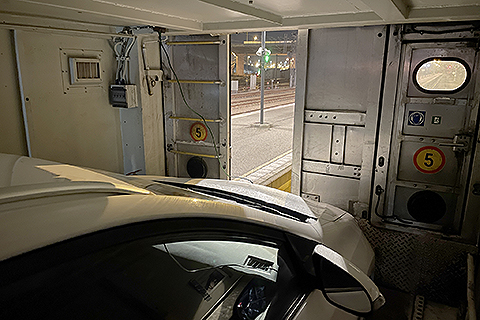
First in, first out—that's
a guarantee against any delays at the destination.
CLICK the photos in this report to see them
in full size in a new browser window.
The IC
265 train embarked on its journey with a somber
note, as a medical emergency resulted in the evacuation
of a person at Tikkurila. Fortunately, this incident
did not cause any lasting delay, and the train reached
Rovaniemi promptly at the scheduled time of 7.20
AM local time on Saturday morning. Moving the car
carriers and unloading of cars was remarkably swift,
allowing me to exit the train station by 7.40. I
was on the road north faster than ever before.

Mika in Rovaniemi before dawn,
awake enough to start driving further north.
Having already enjoyed some snacks
for breakfast during the train journey, I seamlessly
drove a straight 300 kilometers to Ivalo for lunch
and grocery shopping. The travel proved to be a
breeze; despite the temperature hovering around
-20°C, the road conditions were excellent, traffic
was minimal, and the wintry scenery presented a
charming spectacle. I decided to take a detour to
drive atop Fell Kaunispää, only to find
it shrouded in mist with zero visibility. Thus,
no photos.
Upon reaching Ivalo, I encountered
a minor hiccup as my regular grocery store, S-Market
Vaskooli, was closed due to some oil leak. I then
pivoted to K-Supermarket, where I procured enough
groceries to last the entire two weeks.

In Ivalo I also devoured a
huge double burger at Restaurant Ivalo.
Arriving in Aihkiniemi at around
14.15 local time (1215 UTC), I found that the DXers
of the previous week, Jorma Huuhtanen and Lauri
Levanto, had departed just before my arrival. By
1300 UTC, when I had my first receivers up and running,
a mix of stations from Asia filled the airwaves,
though there was nothing particularly noteworthy
from any specific region.
As the evening unfolded, the
sky remained clear, presenting a good opportunity
to capture an initial set of northern lights photos.
The endeavor was not without its challenges. During
periods of tranquil solar weather, only a slender
arc of faint light typically graces the northern
sky. Undeterred, I braved the frigid -23°C temperatures
for a couple of hours, finally reaping the reward
of about ten minutes of captivating aurora action.

Aurora borealis over Aihkiniemi.
Situated
in the darkest regions of Europe according to a
global
light pollution map, our DX cabin Aihkiniemi,
north of Lake Inari, provides optimal conditions
for stargazing and aurora spotting.
Purpose-built for DXing, Aihkiniemi's isolated location
in the wilderness enhances its standing as a premier
spot for AM DXing. For those unfamiliar with AM
DXing, the BBC offers an excellent introduction
to the hobby in this
video report. For seasoned DXers seeking to
delve deeper into the unique aspects of Aihkiniemi,
a YouTube
video and this
article provide valuable insights.
In my DXing endeavors, I employed three Perseus
SDR receivers equipped with Jaguar software. A selection
of 14 permanently installed Beverage-type antennas,
each spanning approximately 1 kilometer (3,300 ft),
are pointed at these directions to maximize reception
of signals from all interesting target areas:

The peak
of the busy Nordic AM DX season had already passed
by the time my expedition in Aihkiniemi commenced.
While Hannu Tikkanen was engaged in DXing in Lemmenjoki
during my second week, I'm not aware of any other
concurrent Arctic DXpeditions in the Nordic countries.
However, numerous remote listening stations now
operate 24/7 across Lapland and northern Norway.
Beyond the realm
of DXing, I took the opportunity to visit several
friends and neighbors, with the closest residing
three kilometers away. It proved to be a great antidote
to any potential cabin fever symptoms, providing
a welcome respite from the solitude.
A significant portion of my time was dedicated to
capturing the enchanting northern lights. The pinnacle
of this experience occurred late in the evening
on November 21, with some of my shots featured on
national TV on the following day as part of the
weather forecasts. Using my new Sony a7R Mark V
paired with Sigma's 14mm lens was a sheer joy, despite
the challenging task of operating the camera barehanded
in the -25°C (-13°F) weather. I am grateful
to still have all my fingers intact after such frigid
photo shoots.

The Aihkiniemi cabins.
The DX headquarters is in the left cabin, while
there's a sauna, kitchen and a bunk bed in the right
one. The shelter in the front houses a well.
Over my two weeks in Lapland, the outside temperature
fluctuated between a bone-chilling -30°C (-22°F)
and just slightly below freezing point. At the start,
a meager 10 cm of snow covered the landscape, growing
to about 25 cm by the time of my departure.
However, for us DXers, our primary
focus lies not on the weather but instead on solar
weather. We diligently monitor changes in solar
indices to forecast AM DXing conditions. The traditional
rule of thumb dictates that low solar activity tends
to be favorable, resulting in stable geomagnetic
conditions and predictable reception of distant
stations, particularly to the northwest, north,
and northeast of Lapland.
Experienced
DXers, however, often challenge this traditional
belief, as stable reception tends to favor the usual
suspects. They argue that a modest solar storm can
be preferable as it disrupts the status quo, introducing
an element of unpredictability on the dial —
provided it doesn't completely obstruct long-distance
reception. To substantiate this perspective, consider
these selected geomagnetic indices during AIH178,
meticulously gathered by Jan Alvestad and available
on solen.info.
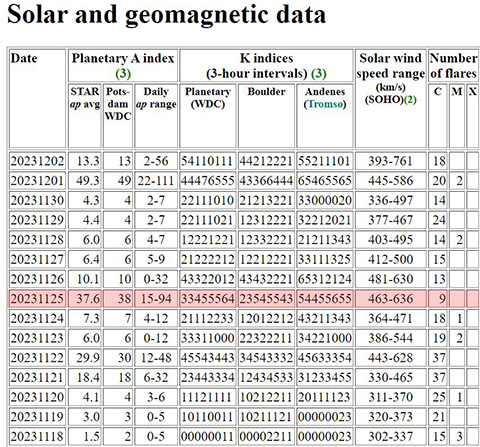
I have
highlighted November 25th because that's when the
A index surged to almost a hundred, and K indices
were also notably high. At 2000 UTC, Kyoto's DST
index plummeted to an extreme low of -99. Traditionally,
most DXers would associate these figures with incredibly
poor reception conditions on the AM band. Conventional
wisdom would suggest that it's time to call it a
night and forget about DXing, perhaps hoping for,
at most, some African stations from due south.
However, what unfolded on the
AM dial on November 25 defied expectations. It marked
the best-ever opening to North America I've experienced
in my 43 years in this hobby! It was a remarkable
event, albeit also one of the shortest openings
ever, making it easily missable. Without this unexpected
bright spot, the entire DXpedition would have been
a disappointing affair.

We have a close relationship
with the great tits and Siberian tits of Aihkiniemi!
No seeds were needed to lure the bird, I just stayed
still for a couple of minutes.
Here's a day-to-day account of how the DXpedition
unfolded — with some surprises.
Sunday, November 19, 2023
With solar indices looking highly
promising, it came as no surprise when US stations
permeated the airwaves overnight. Initially, some
faint signals emerged even before sunset at their
respective locations, although I had no luck with
any daytimer stations.
In the morning, roughly between
0600 and 0800 UTC, signals from the East Coast to
the Midwest exhibited considerable strength. However,
as the day progressed, conditions shifted westward
while also losing much of their initial vigor. Stations
identified during this period included KYFI &
KHOW 630, WTNY 790, WDMC 920, WINZ 940, KFJB 1230,
KWVR 1340, WNYY 1470, and WPAY 1520 AM. Notably,
no personally new stations were identified.

A sharp but gentle knock on
an antenna wire is usually enough to get rid of
snow.
I ventured into the forest to
inspect the first two antennas, clearing them of
accumulated snow. Upon my return at 0920 UTC, some
Asian signals were already audible, but there wasn't
a distinct focus for several hours. The strength
of South Asian signals increased notably after
the sun set in that region around 1230 UTC.
Although I typically don't pay
much attention to pirate stations, Radio Mi Amigo
presented quite a surprise with a formidable signal
on 1503 AM persisting for hours. The transmitter
location seemed relatively close, possibly in Scandinavia.
Later in the evening, I visited
friends in the village of Partakko, so I don't have
a clear idea if my recordings captured anything
noteworthy. Antti and Päivi had prepared a
delightful dinner featuring fried perch, moose fillet,
and mushroom risotto — all locally caught and
picked by themselves. The meal concluded with cloudberries
for dessert, rounding off a delightful evening.

Antti Kokkonen, a fellow
journalist with a cabin in Partakko, used a saw
to carve this huge slab from the 30-cm-thick lake
ice.
|
0459 UTC
|
LRI237 1330 AM, Rosario
|
1330 kHz
|
| 0959 |
Radio
Mi Amigo, UNID QTH |
1503
kHz |
Monday, November 20, 2023
Throughout the night, a few US
stations emerged early on, but their signals were
weak, and the selection of stations was both limited
and very typical. Around 0200–0300 UTC, there
appeared to be some activity from around Brazil
and Argentina. Signals from North America were comparatively
weaker than on Sunday, and even with the sunrise,
there wasn't much of interest. All the identified
stations were familiar ones, including KTRF 1230,
KDLR 1240, WKBK 1290, WIBA & KNOX 1310, KWVR
1340, and KDBM 1490 AM.
Throughout the day, faint signals
from the Pacific Northwest lingered on the dial,
but I opted to spend a couple of hours in the forest
instead, clearing antenna wires of accumulated snow.
Asian signals made a belated
appearance, with my recording starting from 1300
UTC onward yielding little of interest. By 1500
UTC, South Asian signals began to dominate many
frequencies. There were no noteworthy Australian
signals to speak of, with just a couple of the most
usual suspects making an appearance. From Asia,
for instance BCC Taichung on 927 AM was identified.
In the evening, I dedicated some time to crafting
additional BNC cables for the users of Aihkiniemi.
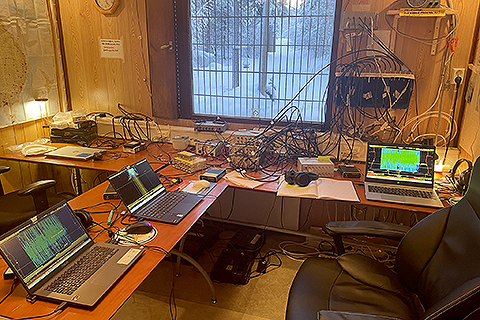
This is what the listening
room equipment looks like: three Perseus receivers,
coupled with Jaguar software on three laptops, and
amplifiers for the antennas.
Tuesday, November 21, 2023
The overnight period was rather
lackluster, but in the morning, roughly between
0600 and 0800 UTC, North American stations exhibited
relatively strong signals. Conditions particularly
favored the Prairie states and the Rocky Mountains.
While there were no personally new stations identified
at this point, familiar ones such as XECL 990, KDIX
1230, KORT 1230, KFBC 1240, KGLB 1310, KTOQ 1340,
and KPRK 1340 AM were among
those recognized.
Throughout the day, the AM band
remained relatively quiet, prompting me to spend
a considerable amount of time in the forest, where
I checked and cleaned several antennas.
The Eastern front proved once
again to be less exciting, and in the late evening,
despite the -24°C weather, I spent hours outside
chasing auroras. The results of this endeavor can
be found below. Interestingly, for the first time
during this DXpedition, the light show included
some fast-moving light phenomena, which were particularly
impressive on video. The shakeup in geomagnetic
conditions also favored AM reception, leading to
the early appearance of New England stations that
peaked at the ideal time of 2100 UTC. While I did
observe some tracks of daytimer signals on the Jaguar
display, they were either familiar cases or remained
unidentified.
CLICK
the aurora photos to see them in full size in a
new browser window:
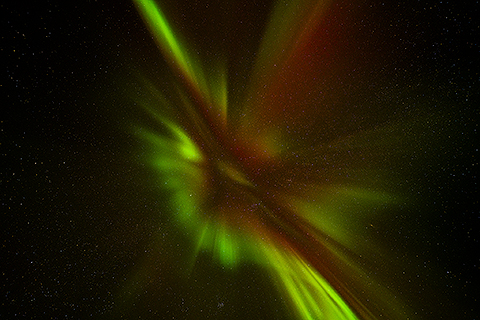
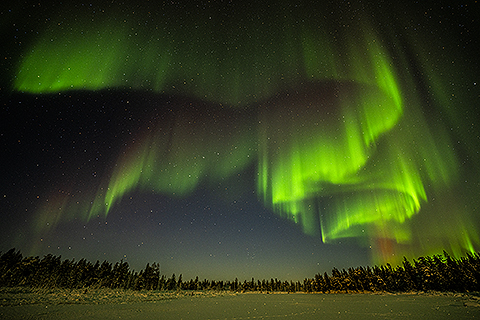


Wednesday, November 22, 2023
Overnight, US signals exhibited
greater strength than on any previous night, marking
a welcome change. It was finally a night of recordings,
warranting some inspection later on. However, around
0600 UTC, everything vanished to the extent that
not even any RNE stations were heard during the
0625 and 0645 UTC local breaks. The AM band mostly
recovered by the next top-of-the-hour, 0700 UTC,
but then subsided again. Among the identified stations
were CHTM 610, WPRV 790, WHCU 870, XECT 1190, WTKG
1230, WMMB 1240, and KICD 1240 AM.
The daytime remained relatively
quiet, with the exception of a brief burst of Japanese
stations around 1000 UTC — an ideal timing,
as it coincided with one of the only two daily breaks
for NHK's 1st channel local station identifications.
Fukushima outlets were particularly strong, and
a Fukushima relay station on 1341 AM proved to be
a new discovery for me.
More antenna maintenance occupied my day, followed
by a disappointingly poor afternoon showing of Asian
stations. The airwaves remained relatively quiet,
with static and atmospheric noise dominating. DYSI
1323 AM was among the few stations from the Philippines
around 1330 UTC, but by 1500 UTC, the focus had
shifted to India.
In the evening, the outside temperature
rose substantially to around -10°C. Some of
my aurora shots ended up being featured twice on
YLE TV news in the evening as a lead-in to the weather
forecast. They also gained popularity as a social
media post. I suppose freezing my toes off was worth
it in the end.
|
0000 UTC
|
WHGB Harrisburg PA
|
1400 kHz
|
| 0000 |
WMGG
Egypt Lake FL |
1470 kHz |
| 0100 |
Radio
COCO, La Habana |
980 kHz |
| 0101 |
+WRKL
New City NY |
910
kHz |
| 1000 |
JOFP
NHK1 Fukushima |
1341
kHz |
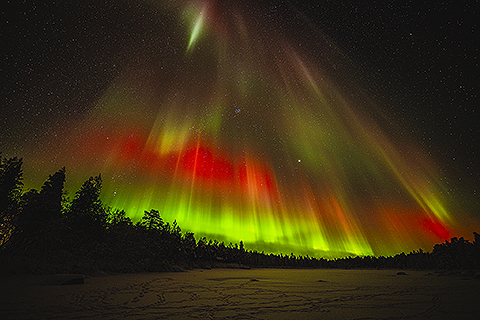
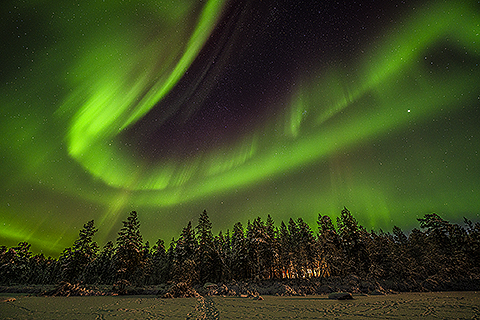


Thursday, November 23, 2023
Measurable North American signals
only surfaced after midnight UTC, but improved significantly
around dawn, coinciding with the period when reception
typically peaks. The signals reached their zenith
around 0600–0800 UTC and were concentrated
in the Canadian Prairie, Minnesota, North Dakota,
and Montana — though
no groundbreaking discoveries were made. Identified
stations during this time frame included WRTO 1200,
KASL 1240, KVXR 1280, KDLM 1340, WJOL 1340, KEYL
1400, KQDJ 1400, KXGN 1400, and KCOW 1400 AM, all
of which are very familiar.
During daylight hours I completed the inspection
and cleaning of the remaining antennas, marking
the conclusion of this duty for my DXpedition unless
any urgent fixes are required. Subsequently, I tackled
shoveling the yard and driveway after a snowfall
of close to 10 cm over the previous 24 hours. After
all these activities, the sauna felt even more rejuvenating
than usual.
The afternoon opening to Asia
was unremarkable, as is often the case this time
of year, with little trace of Aussie stations.
Friday, November 24, 2023
North American signals exhibited
notable strength around 0000 UTC, and with a bit
of back-and-forth movement, dawn brought robust
signals from the Great Lakes and the Great Plains.
However, despite these favorable conditions, the
quest for new stations remained a challenge. Among
the identified stations were KGHL 790, XERDO 1060,
KFTI 1070, KDMR 1190, WKAN 1320, WLBK 1360, WKMI
1360, KFRU 1400, WRMN 1410, and KFIG 1510 AM —
all of which I have already verified. The highlight
of my catches was WKTA Evanston IL on 1330 AM, likely
a first-time reception in Finland.

This was the last time
I saw the sun before the polar night, when sun no
longer rises above the horizon.
Later on, the Midwest was succeeded
by some fairly common stations from the Pacific
Northwest, including KMYC 1410, KYKN 1430, KLBM
1450, and KBKR 1490 AM. Once again, the North American
path folded well before any stations with a pre-sunrise
power hike could be spotted.
A curious case emerged with KMXA
from Colorado on 1090 AM. Its signal had been strong
for several days, but when it closed programming
at 0600 UTC, without any sign-off information, it
continued to air a monotonous non-stop tone for
as long as it could be heard.
Snow work awaited me in the afternoon until it became
too dark to toil outside. The eastern window opened
relatively late. Japan exhibited considerable strength
when NHK1 had a regional break at 1255 UTC, allowing
me to hear, for example, Sendai on 846, 963, 999,
and 1584 AM, as well as Hokkaido on 927, 945, and
1161 AM. Following some common Chinese stations
(such as Wuhan PBS on 1242 and Qinghai EBS on 1251
AM), the band was overwhelmed by European powerhouses.
|
0706 UTC
|
KIOL Iola KS (see this
article!)
|
1370 kHz
|
| 0734 |
KSEK
Pittsburg KS |
1340 kHz |
| 0756 |
WSGB
Sutton WV |
1490 kHz |
| 0759 |
+WKTA
Evanston IL |
1330 kHz |
| 0818 |
XEPBGR
Guadalajara JL |
1510
kHz |
Saturday, November 25, 2023
The big day arrived. Transatlantic
signals emerged around midnight UTC and continued
at varying levels until around 0900 UTC. Latin America
was practically absent, as it had been for most
of the past week. Even North American signal levels
were lower than on Friday. Contrary to NOAA predictions,
space weather conditions turned unfavorable again,
and listening in daylight became quite limited when
indices hit minor storm levels. While I didn't catch
anything new, I did identify, for example, these
stations: WNCO 1340, WAGN 1340, WMAN 1400, KBMW
1450, and WPVL 1590 AM.
Initially, there were quite a
few Japanese stations on the dial, but later on,
the eastern front sort of collapsed, with mostly
static or Arabic stations remaining.
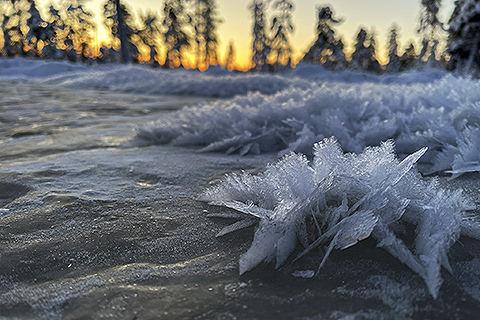
Ice crystals growing upwards
from a swamp.
In the evening, a geomagnetic storm reached the
G2 level, and northern lights were visible throughout
Finland — except
in this region, where the sky remained cloudy. The
Kyoto DST index plummeted to an impressive low of
-99. Here is what NOAA's solar weather report indicated:
MODERATE (G2) GEOMAGNETIC
STORMS OBSERVED – 25 NOVEMBER 2023. Periods
of G1-G2 (Minor-Moderate) geomagnetic storms were
observed on 25 November due to the passage of a
Coronal Mass Ejection (CME). The CME, which is likely
associated with an eruption from 22 November, arrived
at Earth at around 15/0835 UTC. Minor (G1) geomagnetic
storm conditions were observed beginning at 25/0859
UTC, with Moderate (G2) levels observed at 25/2003
UTC. Additional periods of Moderate (G2) storming
are expected through the end of the UTC day on 25
November, and Minor (G1) storming is expected to
continue until 26/0600 UTC.
Despite the bleak outlook, some common New England
stations were heard faintly and briefly
at 2000 UTC. The first sign that something
extraordinary might be unfolding was the absence
of the usual dominant WLQV on 1500 AM, replaced
instead by WFED, heard loud and clear after 2100
UTC. This developed into an exceptionally productive
opening toward West Virginia and surrounding areas,
unimpeded by the usual suspects further north in
New England and the Great Lakes blocking frequencies.
The narrow opening to the Great
Smoky Mountains was strongest from around 2145 UTC
and delivered a motherload of true rarities. Here's
what Jaguar's J-index (JIX) and AM frequency spectrum
looked like during this night. The arrow points
to a oval (darkened for clarity) which marks the
timing of this narrow opening:
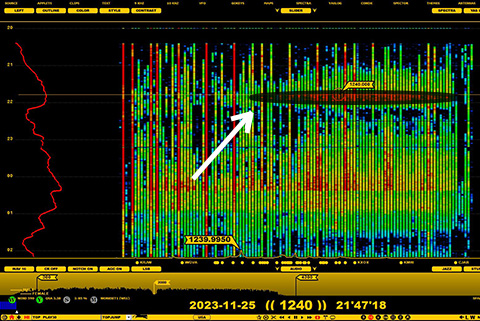
It helps to be a Jaguar user to interpret this,
but to summarize, Y-axis shows the time in UTC.
X-axis includes a vertical display for each channel
from 530 kHz to 1700 kHz at 10 kHz intervals. Black/blue
indicate no audible signal, green denotes a carrier
wave or a very weak audible signal, while yellow
and red would be a stronger signal. The red line
on the left indicates the amount of frequencies
occupied by stations. The further right it extends
from the y-axis, the more stations are audible at
any given time.
Even though on the Jaguar display signals appeared
to be stronger a couple of hours later, the direction
of the opening and the selection of stations had
already returned to normal, which hardly offers
anything new if you've already collected 2,000 verified
stations from North America. I messaged to Hannu
Tikkanen in Lemmenjoki that the beginning of the
night was simply fabulous, but he wasn't convinced.
Maybe this opening was much less impressive in Lemmenjoki.
Here is a chronological animation illustrating the
progression of the Appalachian opening — or
more narrowly the Smoky Mountains opening
— using the Jaguar map as a backdrop.
The animation showcases the southwestward movement
of the sunset line and highlights all the personally
new 18 stations that I identified within 26 minutes,
including 17 of them within the most intense quarter-hour.
Nearly all of these stations became audible well
before local sunset. The final frame depicts the
locations of all the new stations combined, neatly
concentrated around the Great Smoky Mountains, with
many still in daylight when this propagation path
closed just past 2200 UTC. To replay the animation,
refresh your browser window.

The night's list of reported
personally new stations is unprecedented for such
a short time frame. Never before during my 43 years
in the hobby has anything like this happened. Stations
marked with a plus have never before been heard
in Finland, and except for one (WQCH), probably
not elsewhere in Europe either. Links in the station
names open a verification sent to me by the station.
They are PDF files opening in a separate browser
window.
A bit later in the night
I logged a couple of more personally new stations.
All in all, I scored new stations from North Carolina
(5), Virginia (4), West Virginia (3), Pennsylvania
(3), Tennessee (2), South Carolina (1), Georgia
(1) and Puerto Rico (1). I sent all of them reception
reports by the end of 2023, and within a year,
17 of the 20 stations had verified my reports.
Contributing
to the success was a geomagnetic turmoil without
any surge in proton levels. On these latitudes,
a rise in the proton flux tends to silence North
American AM stations completely. As these NOAA
measurements from November 24–26 reveal,
even though the K index rose rapidly just before
the opening, the proton flux didn't flinch.
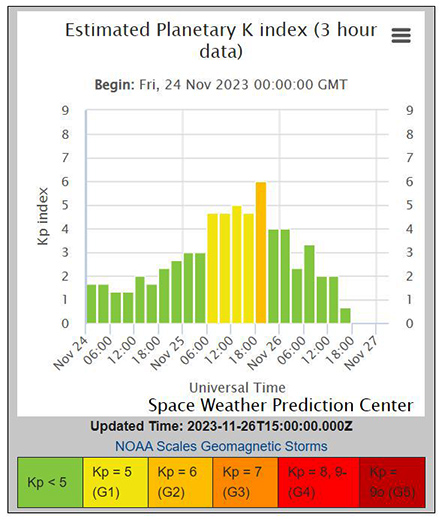
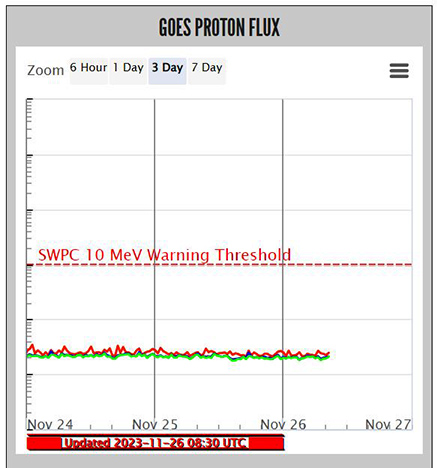
Short and
narrow openings like this are key to success in
advanced AM broadcast band DXing. Usually DXers
determine that conditions are good when stations
from some direction are heard exceptionally well
for hours on end. However, during such instances,
the AM band is often saturated with the usual
lineup of stations. As you collect more stations
and nailing down new ones becomes more difficult,
it is all the more important to focus on spotting
fleeting anomalies in conditions.
For instance, a year earlier on DXpedition AIH163
there was a 15-minute opening to the same Smoky
Mountains area on November 30. And on November
27, I was treated to a seven-minute opening to
the Philippines revealing five new stations (on
top of the over 110 verified stations that I already
had from there). Additionally, on DXpedition AIH139
in 2021 a handful of uprecedented stations from
Kentucky and Tennessee surfaced only during a
three-minute period (on September 20), which didn't
coincide with the top or the bottom of the hour.
Detecting these short bursts requires meticulous
reviewing of the AM band, or carefully inspecting
SDR files when not listening live, but the rewards
are substantial. Despite my diligence, the sheer
volume of recordings makes it impossible to listen
to more than at most 1% of the total, so I may
have missed numerous unique openings. The key
here is to constantly evaluate the implications
of what you do identify. When station X is heard,
what does it mean for the prospects of hearing
station Y, which is on my most wanted list?
Scrutinizing recordings is significantly enhanced
by visual observations of the dial, and in this
realm, the Jaguar beast proves to be an invaluable
ally. Its ability to swiftly reveal unusual offsets
makes it the optimal tool for the task at hand.
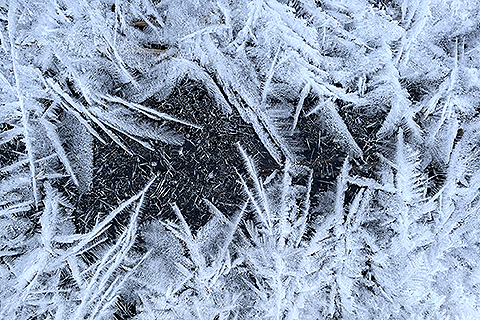
A closeup of how ice gradually
expands.
Sunday, November 26, 2023
The lingering traces of this
opening to the Great Smoky Mountains persisted even
beyond midnight UTC on Sunday. This particular opening,
confined to the Southern Appalachian Highlands,
stood out as the highlight of the DXpedition. However,
strong solar activity had its impact later in the
night, particularly in the morning. Significantly,
North American signals predominantly dissipated
after 0800 UTC, preceding sunrise. It was still
possible to identify for instance WJMK 1250, KROX
1260, WWWI 1270, KPRK 1340, KDLM 1340, WCCY 1400,
WKNW 1400, and WATW 1400 AM.
In the afternoon I paid a visit
to a neighbor and returned to see Japanese stations
booming. This continued for hours. Unfortunately
it is extremely difficult to spot new ones without
NHK local ID breaks. The opening persisted until
the NHK2 closing time of 1600 UTC. In addition to
two personally interesting catches, other NHK stations
identified at that time included 1125 JOLC Tottori,
1467 JOID Oita, 1602 JOFD Fukushima, JOSB Kitakyushu
and JOHC Kagoshima.
|
0007 UTC
|
+WLRT Nicholasville KY
|
1290 kHz
|
| 0009 |
HJAV
Radio Uno, Montería |
1220
kHz |
| 0045 |
WMTN
Morristown TN |
1300
kHz |
| 0616 |
ZYI823
Nova Rádio Cultura, São José
do Egito PE |
1320
kHz |
| 1230 |
JOTR
ABS Akita |
936
kHz |
| 1600 |
JOLC
NHK2 Tottori |
1125
kHz |
| 1600 |
+JOFC
NHK2 Fukui |
1359
kHz |

A Siberian tit aka grey-headed
chickadee is the most common visitor at our feeding
station.
Monday,
November 27, 2023
Transatlantic signals appeared
very slowly in the wee hours but improved steadily
until collapsing around 0830 UTC. The strongest
stations were from the Canadian Prairie, Minnesota,
and the Dakotas, so there are hardly any surprises
in my recordings. I identified, for instance, WMTR
12540, KGLB 1310, KDLM 1340, KQDJ 1400, WATW 1400,
and WVTL 1570 AM.
I was working when Asian stations
were heard, but after reviewing the recordings later,
there wasn't much new. NHK2 stations closed down
at 1440 UTC. Around 1400–1500 UTC Australian
ABC stations emerged briefly on 1062, 1233 and 1431
AM, but I already have them verified. In the evening,
Greek pirate stations seemed to occupy several frequencies
on the AM dial. A couple of nice surprises from
the east, however, including a new Chinese station
solved by fellow DXer and China expert Chris Kadlec:
|
1400 UTC
|
+Liaoyang PBS (Traffic Literary R), Liaoyang
LN
|
1143 kHz
|
| 2100 |
+JOUB
NHK2 Akita via Hanawa |
1521 kHz |
Tuesday, November 28, 2023
Daybreak brought some common
North American stations up for a while, but it didn't
last long. Asian stations started popping up before
1100 UTC, but then retreated for a couple of hours
later in the afternoon. I spent the day working,
so I assessed reception conditions in detail much
later. The outcome of my recordings turned out to
be crappy, with nothing interesting from any direction.

Otsamo Fell as seen from
Highway 4 when I was on my way up to Aihkiniemi.
Wednesday, November 29, 2023
While trying to work, I hardly took any notes on
this day. The morning and the afternoon didn't appear
very impressive, and further scrutiny confirmed
my suspicions. From Asia, it can be mentioned that
DYRD on 1161 AM was logged at sign-off 1501 UTC,
but this is of course not a rarity.
Thursday, November 30, 2023
Transatlantic signals were extremely slow to emerge,
but when signals finally became reasonable at dawn,
there were also stations from Colombia, Peru, and
Puerto Rico in the mix. The emphasis remained on
the East Coast relatively long before shifting to
the Midwest. For the first and only time on this
DXpedition, some midwestern stations lingered until
past 1200 UTC, which made it possible to search
for daytime-only stations using pre-sunrise power.
Unfortunately, signal levels had fallen so low that
only the most common dominants were still audible,
such as WLCM 1390, WXNT 1430, and WCGO 1590 AM.
Focusing on work, I didn't really
observe Asian stations except to note that the NHK2
closing time at 1440 UTC didn't reveal any rarities.
Late in the evening, when stations in the Philippines
began a new broadcast day, I was lucky to hear two
personally new stations.
|
0400 UTC
|
WATT
Cadillac MI |
1240
kHz |
| 0530 |
HJDM
Tropicana, Medellín |
830
kHz |
| 0600 |
WCGB
Juana Diaz PR |
1060
kHz |
| 0630 |
HJDC
Múnera Eastman Radio, Medellín
|
790
kHz |
| 0729 |
+WALG
Albany GA |
1590
kHz |
| 0809 |
WGVL
Greenville SC |
1440 kHz |
| 1950 |
DZGR
Tuguegarao |
891 kHz |
| 2104 |
DXKI
Koronadal City |
1062 kHz |
 There are some sharp turns
on Highway 4 at its highest point near Saariselkä.
There are some sharp turns
on Highway 4 at its highest point near Saariselkä.
Friday, December 1, 2023
Overnight was a disappointment, because theoretically
this could have been the best night of the month
to catch daytimer stations, but conditions just
were not good enough. At least the morning peak
at 0600–0700 UTC was pretty strong. The emphasis
was even further north than normally, favoring stations
from Ontario, Michigan, and New York. Graveyard
channels produced better signals than before, although
nearly all stations turned out to be familiar ones.
For instance, the following stations were identified:
KYFI 630, WFIR 960, WKHM 970, WSOO 1230, WOMT 1240,
WTAX 1240, WENK 1240, WCBY 1240, WBBW 1240, WJIM
1240, WGDJ 1300, WKAN 1320, WNCO 1340, WAGN 1340,
WWWL 1350, WOYK 1350, WGIL 1400, WWWS 1400, WMAN
1400, KFRU 1400, WRJN 1400, WSAM 1400, WNGL 1410,
WLEC 1450, WIOE 1450, KMRY 1450, WMRN 1490, and
WPAY 1520 AM.
After my workday, I visited Antti's
brother Pekka and his wife in Partakko. Pekka is
a talented fisherman, and this time of the year
he uses nets under the ice. I was very grateful
for a fresh trout fillet, which he gave, and which
I froze for Christmas.
Later on, it was time for the
last sauna, cleaning, and filling up all the water
buckets. Late in the evening, Asian stations were
pretty strong, including Thai stations before sunrise
in Thailand.
|
0700 UTC
|
WEMG Camden NJ
|
1310 kHz
|
| 0707 |
WDCT
Fairfax VA |
1310 kHz |
| 0755 |
WBBD
Wheeling WV |
1400 kHz |
Saturday, December 2, 2023
The day of departure. Transatlantic signals were
quite weak overnight but began to improve a bit
after 0600 UTC. Reception was decent around 0700–0800
UTC, and turned gradually downhill thereafter. I
started to pack my DX gear but waited until 1000
UTC to pull the plug from the last receiver.
For example, these stations were identified: WLAK
1260, WSKO 1260, WMKT 1270, KGLB 1310, WQSC 1340,
KVBR 1340, WOND 1400, WATW 1400, WKEI 1450, KATE
1450, and KGFK 1590 AM. The morning catch contained
one especially neat station, which should not even
have been on the air. I sent a reception report
to Kentucky right away and received a friendly confirmation.
|
0706 UTC
|
WMFG Hibbing MN
|
1240 kHz
|
| 0800 |
+WMTL Leitchfield
KY |
870
kHz |
I had made a lot of preparations
already on the previous evening, so hauling the
last bags to the car was pretty quick. After cleaning
the cabin, I was on my way south before 13.00 local
time.

Joakim, Jari and Mika
at Neste in Inari.
Driving conditions were again very nice, but daylight
didn't last too long. At a Neste service station
in Inari I met Jari Luoma and Joakim Weckström,
who would be spending a week in Aihkiniemi after
me. This was the first Lapland DXpedition for Joakim,
and I'm convinced he will be overwhelmed by the
vast amount of new stations he is going to hear.

The pizzas at the Rovaniemi
railway station were pretty good – although
Hannu's pizza wasn't the one he ordered.
Then I continued straight down to Rovaniemi without
pit stops, and caught up with Hannu Tikkanen, who
was taking the same train. After we loaded our cars,
we enjoyed beer and pizza at Restaurant Alvari at
the Rovaniemi railway station. My unsurprising choice
was the "Rovaniemi" pizza based on smoked
reindeer.
The train ride home was uneventful and quite relaxed.
AIH178 was one of those DXpeditions when a positive
outcome was already in the cards and not dependent
only on the catches to be made during months of
intensive scrutiny of SDR recordings.
This season I spent a total of four weeks in Aihkiniemi,
and I have to say that reception conditions were
a really positive surprise considering that we are
almost at the peak of the solar cycle. I have much
more recordings to dissect than I originally expected.
Here you can check out the full
log of new stations in frequency order and the
log listed by day
and time (PDF).
Text
and photos: Mika
Mäkeläinen
Published on January
30, 2025
  
|